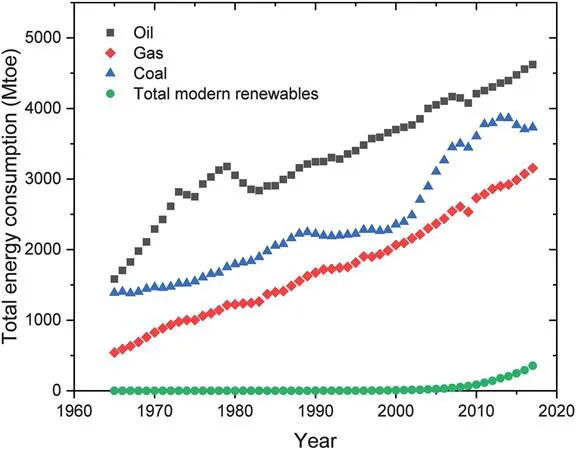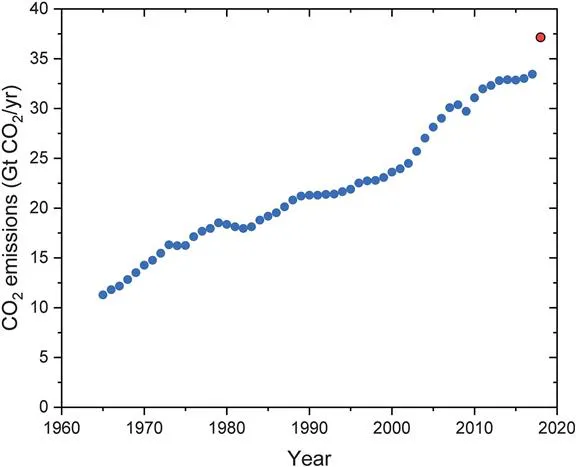1.1 Introduction
Humanity is profoundly good at exploiting the Earth's abundant supply of fossil fuels, and we have built our global economy on this basis. This in and of itself is not a bad thing. The challenge is that our exploitation of these natural resources has been carried out in an unsustainable way for well over a century. We are now firmly ensconced in the Anthropocene, and the effects are becoming increasingly apparent.†
In 1965, global population, gross domestic product (GDP), and CO2 emissions were 3.34 billion, $1.97 trillion, and 11.29 GtCO2, respectively. For the UK, those figures were approximately 54.24 million, $100 billion, and 687.8 MtCO2. By 2017, the global figures had increased to 7.55 billion, $80.93 trillion, and 33.44 GtCO2. For the UK in the same year, those figures were approximately 66.73 million, $2.63 trillion, and 398.2 MtCO2.1–3
In 1965, fossil fuels provided 94% of the world's energy, with modern renewable energy, i.e. wind and solar power, providing approximately 0%. By 2017, the share of fossil energy had decreased to 85%, but modern renewables had only increased to 3% of the total energy consumption. The balance was supplied by nuclear power (4%) and hydro power (7%). These data, illustrated in Figure 1.1, are offered not as condemnation nor endorsement, rather simply as facts.
Figure 1.1 Global primary energy consumption since 1965. Data from the BP Statistical Review of World Energy, June 2018.1
At the time of writing,‡ and as illustrated in Figure 1.2, estimates are that anthropogenic CO2 emissions in 2018 significantly exceed those in previous years. This is despite the conclusion of the 2015 Paris Agreement of the United Nations Framework Convention on Climate Change (UNFCC), wherein it was agreed to keep “global temperature rise this century well below 2 degrees Celsius above pre-industrial levels and to pursue efforts to limit the temperature increase even further to 1.5 degrees Celsius”.4
Figure 1.2 Total anthropogenic CO2 emissions. Data from the BP Statistical Review of World Energy, June 2018.1 The red data point shows the provisional data point for 2018.
Thus, the evident inertia of the global energy system, combined with recent legally binding legislation requiring the transition to a net zero emissions economy by 2050§ require that we find a pragmatic solution. This solution must necessarily be socially equitable, technically feasible, and financially viable,¶ if it is ever to become more than an academic thought experiment.
It is this pragmatism that brings us to the concepts of carbon capture and storage (CCS) and greenhouse gas removal (GGR). The term “CCS” refers to a suite of technologies that can enable the continued exploitation of fossil energy resources, but with the additionality of capturing the carbon released upon their combustion, and its subsequent resequestration in the lithosphere. Put another way, CCS is an example of the circular economy concept – the carbon has been stored in the lithosphere for millions of years. CCS involves simply putting it back, as opposed to dumping it into the atmosphere as has been common practice since the industrial revolution. GGR also refers to a suite of options,|| such as bioenergy with CCS (BECCS), direct air capture (DAC) and afforestation, for the removal of greenhouse gases, primarily CO2, from the atmosphere.
An important point about both CCS and GGR (e.g., BECCS or DAC) is that they primarily rely upon technical elements that are individually mature and well-understood. The concept of removing CO2 from a gas stream was developed in the 1930s.8 There are currently more than 7000 km of CO2 pipelines in the US alone,9 and whilst CO2 injection for enhanced oil recovery has been commercial practice in the United States since 1972,** CO2 injection into saline aquifer formations in the North Sea has been ongoing at the Mt scale since 1996 in the Sleipner field. Importantly, geologically sequestered CO2 can be considered to be secure (e.g. Miocic et al.10 and Postma et al.11). Obviously, further research and innovation will improve existing options, and develop new options, but there are no insurmountable technical problems that prohibit the immediate deployment of these technologies in the energy and industrial sectors.
Moreover, it is understood, via the Intergovernmental Panel on Climate Change (IPCC) that both CCS and GGR are indispensable to meeting the terms of the Paris Agreement. CCS was found to be uniquely important in meeting the original 2 °C target – the majority of scenarios could not be solved without it, and those that could found solutions that were, on average, 138% more costly.†† Put another way, ensuring the availability of CCS is more important to meeting our climate targets than any of nuclear, renewable, or bio energy. GGR has become prominent for two primary reasons – offsetting hard to reach emissions, such as those from aviation or agriculture, in terms of conventional mitigation, and addressing what now appears to be the inevitable overshoot of the remaining budget13,14 commensurate with the 1.5 °C target. In this context, it is vital to recognise that GGR is not, in any way, an alternative to mitigation. It is an addition. There are no credible scenarios that meet the Paris target that do not require the large scale removal of CO2 from the atmosphere. In some scenarios, the amount of CO2 being removed from the atmosphere in 2100 is in the order of 20 GtCO2 per year – approximately the amount being emitted in 1990. This is a very large number.
Given the broad agreement on their importance, and their technological maturity, it might be surprising that there are so few large scale projects currently operating. The UK, for example, clearly recognises the importance of CCS, with Her Majesty's Government (HMG) having made three attempts to deploy the technology in the power sector since the G8 Summit in 2005. They all – obviously – failed.
Whilst the reasons for failure are manifold and nuanced, one important aspect is market failure. Whereas with wind or solar power, the product is obvious – renewable energy. Many regions have specific targets for explicitly renewable energy,‡‡ thus creating a market. Revenue stabilisation is thereafter provided via Contracts for Difference (CfDs), or equivalent instruments. The combination of market creation and revenue stabilisation clears the way for investment. The same is not true for “low carbon” – or even “zero carbon” – energy.
There is also the issue of cost; inaugurated in 2013, the London Array comprised 175 individual turbines and a capacity of 630 MW, and came at a cost of £1.8 billion. In other words, it is possible to have commercially operating wind power for some tens of millions of pounds – relative chicken feed. Note that the first commercial wind farm was an onshore 0.6 MW array of twenty 30 kW wind turbines deployed in New Hampshire in 1980.
As CCS is intended to integrate with conventional power generation, it necessarily comes on a large scale. For example, the White Rose CCS project was going to generate 426 MW of electricity and store 2 MtCO2 per year in a saline aquifer. The economies of scale of power generation and CO2 transport and storage infrastructure simply do not lend themselves to small scale operation. CCS necessarily comes with a large price tag – failure is costly.
The point around infrastructure is also important – deploying CCS means deploying the full chain; the capture, transport, and storage. Conventional wisdom says that the majority of the cost is associated with the initial capture step, which is true. However, the majority of the risk comes from the integration of the chain, and the liability associated with the long term storage of the CO2, which affects project price. Thus, at the time of writing, understanding exactly how to price this risk and manage this liability in the context of different sectors is still emerging. A key part of managing this will be close engagement between the public and private sectors: both sectors co-created the problem of climate change,§§ both sectors will necessarily have to work together to co-create the solution, recognising the value of CCS15 to the least cost, and a resilient energy system that delivers upon our climate goals.
Similar problems will, no doubt, be faced with the deployment of GGR technology. In the case of BECCS, it is necessary to go further and recognise the value of both biorenewable energy, and also that of removing the CO2 from the atmosphere. Arguably, given that CO2 in the atmosphere is a common global problem, it...


